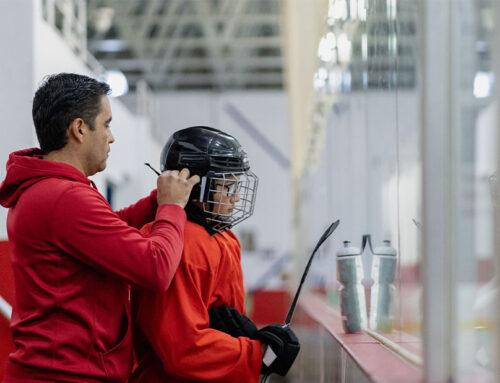5 Little League Baseball Drills to Teach Fielding and Throwing
“You could be a kid for as long as you want when you play baseball.”
– Cal Ripken Jr.
All the little league drills we teach focus on fundamentals. The great thing about baseball is that if you learn and can perform fundamentals at an early age, you will be able to play the game all the way through high school. The key thing for coaches and parents is to stay dedicated to these five baseball drills and always go back to the basics every year.
1. Fielding on Their Knees
When a player in on his knees, several things happen that automatically teach the proper way to field a ground ball. First, the position forces the athlete to have his hands out front. This is key, since a common mistake for young players is fielding the ball too deep between their feet and missing it. Players should field every ground ball with their hands out front. Another bonus of the position? When the hands are out front, he can actually see the ball enter the glove.
Here’s a helpful video where the guys from Infield Fundamentals explaining how to help an athlete set up for this drill:
The drill also helps you teach an athlete how to better read hops, and when to switch from forehand to backhand. But all of that comes after you establish that good fundamental technique of—you guessed it—having the glove out front and on the ground.
RELATED: See our guide to teaching hitting fundamentals
2. Ready Position
Here’s a quick tutorial that quickly covers the three main points of the ready position:
All players on defense should be moving just before the ball is hit. The infielders and outfielders who get into an athletic stance with their feet hitting the ground when the ball is hit learn how to get a jump on the ball. This should be taught to every baseball player.
The easiest way to teach this drill is to have everyone in the field do it during batting practice and fielding practice. We also do it with the coach raising his knee, prompting the fielder to “jump.” Then the coach either rolls, throws or flips the ball in the air to the player.
RELATED: Baseball Fielding Drills for Quick Hands and Feet
3. 1-2-Field, 3-4-Throw
The ability to move through the baseball is the best way to field and throw. We use “1-2-Field, 3-4-Throw” as our cadence for this drill. (You can see a demo below. They call it 1-2-Field, 1-2 Throw but it’s the same basic idea.)
We teach the drill with a ball lying on the ground and have the fielder move slowly to the ball. For a right-handed fielder it could also be Right-Left-Field, Right-Left-Throw (opposite footwork for left-handers). This is the best drill for teaching fielders to stay low through the ball and take minimal steps to throw the ball to the target.
4. Catching Fly Balls
This can be one of the most difficult drills for young players, because judging a fly ball is a learned task. We can roll a ball to a player of any age and he will attempt to stop it. When the ball is in the air, he may not be so eager to catch it. The reason for this is that players are afraid of failure and get hitting in the face with the ball. Therefore, start with tennis balls and no glove for this drill.
RELATED: Improve Your Fielding Prowess with Two-Knee Drills
The player is approximately 5 feet away from the coach, who lifts a knee to prompt the player to get into ready position. At that point, we toss the ball to the player, allowing him to catch it. Technique is not the first goal for teaching this drill; first we want to build confidence. We continue to develop players with a tennis ball, then add the glove, then add a real baseball.
5. Throw at the balloon
We have the kids demonstrate how they throw before we begin teaching them how we think they should throw. Many kids can pick up a ball and throw it at a target. We use a helium balloon tied to a batting tee to teach throwing to a target. This is a fun drill for kids of all ages. Again, we use a counting system of 1-2-throw (or 3-4-throw to coincide with the above mentioned fielding drill). We add fielding drills to work through to this throwing drill.
We ask the players to step toward their target and point their front elbow/glove toward the target before they throw. The main thing we like to see young athletes learn is to use their whole body to throw a baseball. Keeping the throwing elbow above the collar bone from arm whip (catapult) to release reduces the chance of injury.
BONUS: Relay
Divide the team into two teams and have them throw the ball down and back as the picture above illustrates. We have them roll the ball and work on 1-2-Field, turn and roll to the player behind them. This little competition is a good way to keep players motivated during drill work. Any time a coach or parent can add a competitive aspect to drill work, it will benefit the athlete as he gets older.
READ MORE BASEBALL CONTENT:
- Outfield Drills for Youth Baseball
- Check out These Helpful Drills for Pitchers
- See the Best Cleats on the Market—with Advice from an MLB Team Equipment Manager
- Throwing Drills for Building Arm Strength
RECOMMENDED FOR YOU
MOST POPULAR
5 Little League Baseball Drills to Teach Fielding and Throwing
“You could be a kid for as long as you want when you play baseball.”
– Cal Ripken Jr.
All the little league drills we teach focus on fundamentals. The great thing about baseball is that if you learn and can perform fundamentals at an early age, you will be able to play the game all the way through high school. The key thing for coaches and parents is to stay dedicated to these five baseball drills and always go back to the basics every year.
1. Fielding on Their Knees
When a player in on his knees, several things happen that automatically teach the proper way to field a ground ball. First, the position forces the athlete to have his hands out front. This is key, since a common mistake for young players is fielding the ball too deep between their feet and missing it. Players should field every ground ball with their hands out front. Another bonus of the position? When the hands are out front, he can actually see the ball enter the glove.
Here’s a helpful video where the guys from Infield Fundamentals explaining how to help an athlete set up for this drill:
The drill also helps you teach an athlete how to better read hops, and when to switch from forehand to backhand. But all of that comes after you establish that good fundamental technique of—you guessed it—having the glove out front and on the ground.
RELATED: See our guide to teaching hitting fundamentals
2. Ready Position
Here’s a quick tutorial that quickly covers the three main points of the ready position:
All players on defense should be moving just before the ball is hit. The infielders and outfielders who get into an athletic stance with their feet hitting the ground when the ball is hit learn how to get a jump on the ball. This should be taught to every baseball player.
The easiest way to teach this drill is to have everyone in the field do it during batting practice and fielding practice. We also do it with the coach raising his knee, prompting the fielder to “jump.” Then the coach either rolls, throws or flips the ball in the air to the player.
RELATED: Baseball Fielding Drills for Quick Hands and Feet
3. 1-2-Field, 3-4-Throw
The ability to move through the baseball is the best way to field and throw. We use “1-2-Field, 3-4-Throw” as our cadence for this drill. (You can see a demo below. They call it 1-2-Field, 1-2 Throw but it’s the same basic idea.)
We teach the drill with a ball lying on the ground and have the fielder move slowly to the ball. For a right-handed fielder it could also be Right-Left-Field, Right-Left-Throw (opposite footwork for left-handers). This is the best drill for teaching fielders to stay low through the ball and take minimal steps to throw the ball to the target.
4. Catching Fly Balls
This can be one of the most difficult drills for young players, because judging a fly ball is a learned task. We can roll a ball to a player of any age and he will attempt to stop it. When the ball is in the air, he may not be so eager to catch it. The reason for this is that players are afraid of failure and get hitting in the face with the ball. Therefore, start with tennis balls and no glove for this drill.
RELATED: Improve Your Fielding Prowess with Two-Knee Drills
The player is approximately 5 feet away from the coach, who lifts a knee to prompt the player to get into ready position. At that point, we toss the ball to the player, allowing him to catch it. Technique is not the first goal for teaching this drill; first we want to build confidence. We continue to develop players with a tennis ball, then add the glove, then add a real baseball.
5. Throw at the balloon
We have the kids demonstrate how they throw before we begin teaching them how we think they should throw. Many kids can pick up a ball and throw it at a target. We use a helium balloon tied to a batting tee to teach throwing to a target. This is a fun drill for kids of all ages. Again, we use a counting system of 1-2-throw (or 3-4-throw to coincide with the above mentioned fielding drill). We add fielding drills to work through to this throwing drill.
We ask the players to step toward their target and point their front elbow/glove toward the target before they throw. The main thing we like to see young athletes learn is to use their whole body to throw a baseball. Keeping the throwing elbow above the collar bone from arm whip (catapult) to release reduces the chance of injury.
BONUS: Relay
Divide the team into two teams and have them throw the ball down and back as the picture above illustrates. We have them roll the ball and work on 1-2-Field, turn and roll to the player behind them. This little competition is a good way to keep players motivated during drill work. Any time a coach or parent can add a competitive aspect to drill work, it will benefit the athlete as he gets older.
READ MORE BASEBALL CONTENT:
- Outfield Drills for Youth Baseball
- Check out These Helpful Drills for Pitchers
- See the Best Cleats on the Market—with Advice from an MLB Team Equipment Manager
- Throwing Drills for Building Arm Strength










